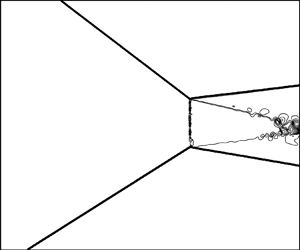Published online by Cambridge University Press: 27 October 2021

The transition criteria seen from the ground frame are studied in this paper for asymmetrical reflection between shock waves moving at constant linear speed. To limit the size of the parameter space, these criteria are considered in detail for the reduced problem where the upper incident shock wave is moving and the lower one is steady, and a method is provided for extension to the general problem where both the upper and lower ones are unsteady. For the reduced problem, we observe that, in the shock angle plane, shock motion lowers or elevates the von Neumann condition in a global way depending on the direction of shock motion, and this change becomes less important for large shock angle. The effect of shock motion on the detachment condition, though small, displays non-monotonicity. The shock motion changes the transition criteria through altering the effective Mach number and shock angle, and these effects add for small shock angle and mutually cancel for large shock angle, so that shock motion has a less important effect for large shock angle. The role of the effective shock angle is not monotonic on the detachment condition, explaining the observed non-monotonicity for the role of shock motion on the detachment condition. Furthermore, it is found that the detachment condition has a wavefunction form that can be approximated as a hybrid of a sinusoidal function and a linear function of the shock angle.